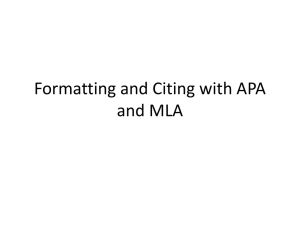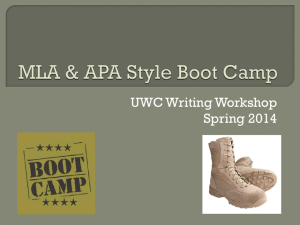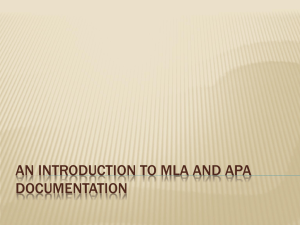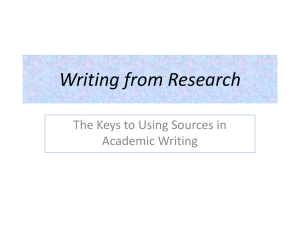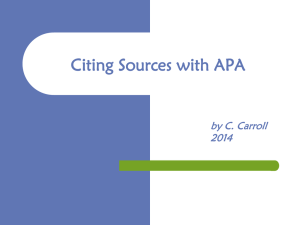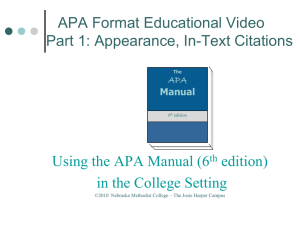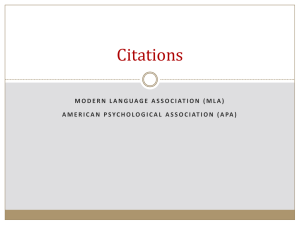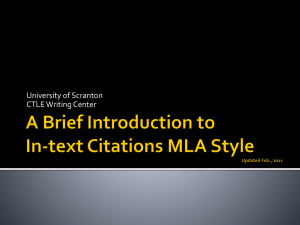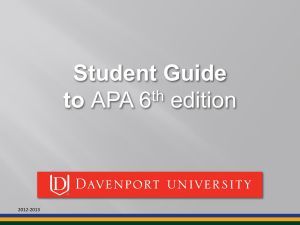MLA and APA Documentation - Columbus Technical College
advertisement
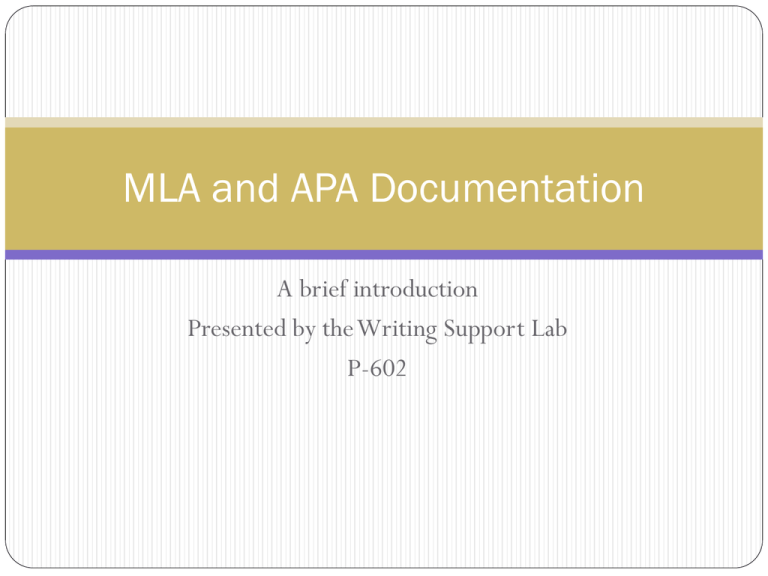
MLA and APA Documentation A brief introduction Presented by the Writing Support Lab P-602 Writing Support Lab Open Monday- Thursday 8am-8:30 pm writing@columbustech.edu 706-649-1728 More info on the bookmarks we handed out! What are MLA and APA? Provide readers with cues they can use to follow your ideas more efficiently and to locate information of interest to them Allow readers to focus more on your ideas by not distracting them with unfamiliar formatting Establish your credibility or ethos in the field by demonstrating an awareness of your audience and their needs as fellow researchers Protect you against claims of plagiarism by showing that you have properly documented your source material Standards established by the styles These documentation styles establish standards of written communication concerning: the organization of content writing style including stylistic technicalities (e.g. abbreviations, footnotes, quotations) citing references/sources formatting and page layout and how to prepare a manuscript for publication in certain disciplines. A rundown of the major parts of the documentation styles Basic Manuscript format in each (example shown in Word) – look at handouts from OWL. We have more complete manuscript guides in the Writing Lab. Basic MLA format Basic APA format Basic APA format Exercise – Preparing some sample sources in reference pages for MLA and APA Puzzle pieces – What order do they go in? APA – Book with Multiple Authors. Calfee, R. C., & Valencia, R. R. (1991). APA guide to preparing manuscripts for journal publication. Washington, DC: American Psychological Association. APA – Article from a database Smyth, A. M., Parker, A. L., & Pease, D. L. (2002). A study of enjoyment of peas. Journal of Abnormal Eating, 8(3), 120-125. APA - Article or Chapter in an Edited Book Author, A. A., & Author, B. B. (Year of publication). Title of chapter. In A. Editor & B. Editor (Eds.), Title of book (pages of chapter). Location: Publisher. MLA – Book with Multiple Authors Gillespie, Paula, and Neal Lerner. The Allyn and Bacon Guide to Peer Tutoring. Boston: Allyn, 2000. Print. MLA – Article from a Scholarly journal in a database Wheelis, Mark. "Investigating Disease Outbreaks Under a Protocol to the Biological and Toxin Weapons Convention." Emerging Infectious Diseases 6.6 (2000): 595-600. Web. 8 Feb. 2009. MLA – Article or Chapter in a Book Lastname, First name. "Title of Essay." Title of Collection. Ed. Editor's Name(s). Place of Publication: Publisher, Year. Page range of entry. Medium of Publication. Examples of sources in each style Look at your Answer Sheets handout for examples of three common sources in MLA and APA style. In-text Citations in MLA and APA What are they? In MLA: In-text citations provide a map for readers and scholars to follow. A reader should be able to look at your in-text citation and refer to the Works Cited page for more information on the source that is used in the paper. Generally, in-text citations include the last name(s) of the author(s) and the page number(s) of the information cited. No comma within the parentheses. In APA: In-text citations provide a map for readers and scholars to follow. A reader should be able to look at your in-text citation and refer to the References page for more information on the source that is used in the paper. Generally, in-text citations include the last name(s) of the author(s) and the year of publication, separated by a comma. Page numbers are generally used when quoting or paraphrasing a source. In-text Citations in MLA and APA MLA Examples: o Many people quote scholars (Jones 456). Jones states that “many people quote scholars” (456). o o General: Two Authors: (Jones and Williams 456) According to Jones and Williams, “Quoted text goes here” (456). No author: (“Name of Article” 456) o Author/No page: (Jones). APA Examples: o General: Many people quote scholars (Jones, 2003). Jones (2003) agrees with the idea that… o o o General- Direct Quote: (Jones, 2003, p. 456). Two Authors: (Jones & Williams, 1999) No author: (“Name of article,” 2003) Resources to help you with MLA or APA The Writing Support Lab OWL (Online Writing Lab) at Purdue.edu CitationMachine.net Galileo Databases Style Handbooks (APA and MLA or Easy Writer) DO NOT USE MS Word References feature. Questions?
